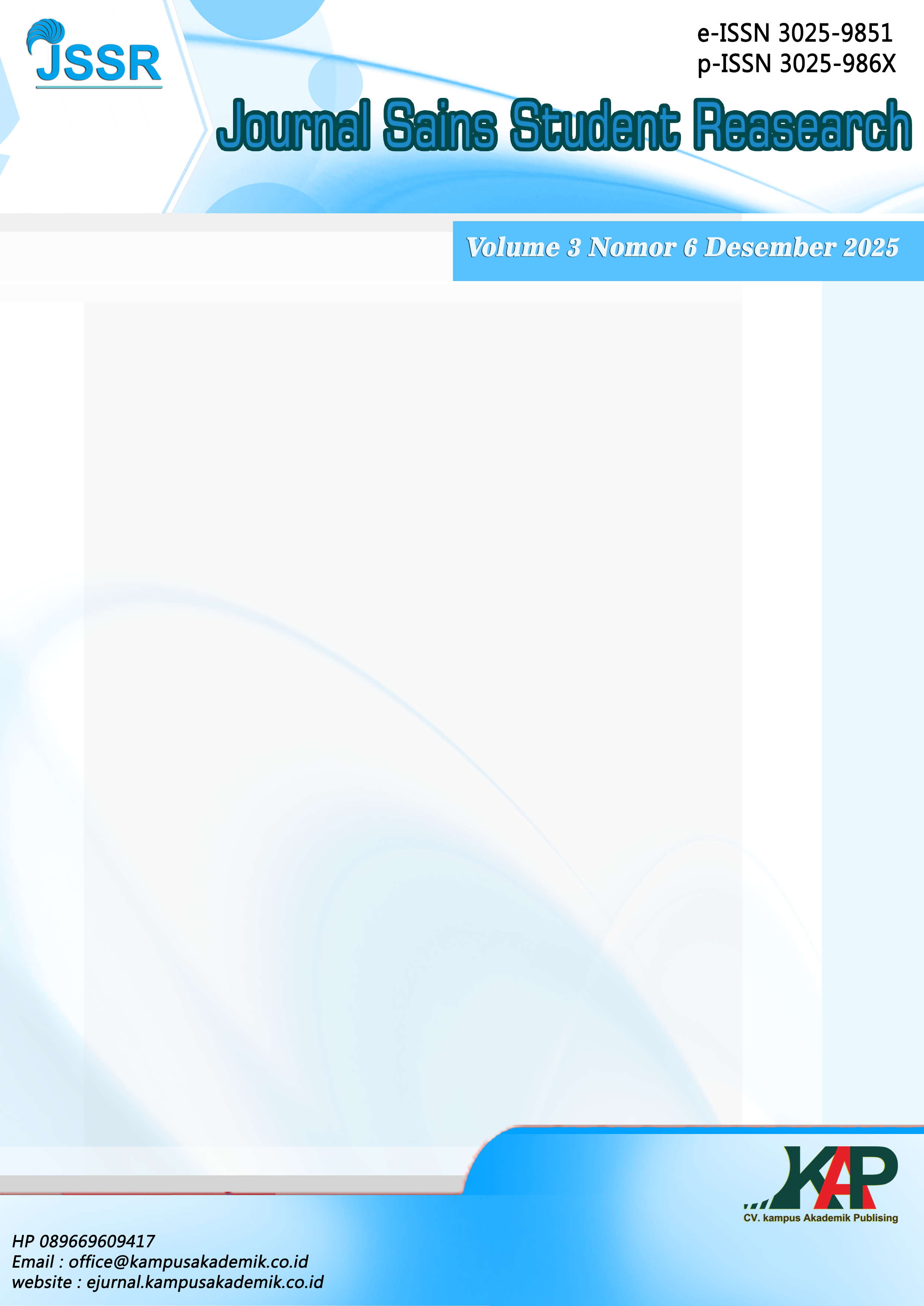FAKTOR-FAKTOR PENYEBAB KEJADIAN STUNTING PADA BALITA DI DESA SIMARIGUNG KECAMATAN DOLOKSANGGUL KABUPATEN HUMBANG HASUNDUTAN
DOI:
https://doi.org/10.61722/jssr.v3i6.6769Keywords:
Stunting, Toddlers, Children, NutritionAbstract
Stunting, or short stature, is a chronic malnutrition problem caused by prolonged nutritional deficiency, resulting in growth disorders in children. The purpose of this study was to determine the factors causing stunting based on parity, family income, duration of breastfeeding, availability of clean water, and mothers' knowledge about stunting. This study used a descriptive analytical method with a cross-sectional design. The population consisted of 123 individuals, and the sample size was determined using the Slovin formula, resulting in 50 participants. Data were collected using questionnaires and analyzed using the chi-square test. This study shows that parity has a significant effect on stunting using a chi-square test with a 90% confidence level and df= 3, yielding a calculated ????2 (9.058) >????2table (6.251) and a p-value of 0.02<0.05. The family income variable has a significant relationship with the incidence of stunting using a chi-square test with a confidence level of 90% and df = 3, yielding a calculated ????2 (10.495) >????2 table (6.251) and a p-value of 0.01<0.05. The variable of duration of exclusive breastfeeding has a significant relationship with the incidence of stunting using a chi-square test with a confidence level of 90% and df = 1, yielding a calculated χ² (6.549) > table χ² (2.705) and a p-value of 0.01<0.05. The variable of mothers' knowledge about stunting has a significant relationship with the incidence of stunting using the chi-square test with a confidence level of 90% and df = 2 obtained. Calculated ????2 (7.274) > table ????2 (4.605 and p-value 0.02<0.05.
References
Ambarwati et al, (2019). Faktor Risiko Kejadian Stunting Pada Balita Di Wilayah Kerja Puskesmas Simpang Pandan Kecamatan Geragai Kabupaten Tanjung Jabung Timur. Journal of Healthcare Technology and Medicine Vol. 6 No. 2 Oktober 2020 Universitas Ubudiyah Indonesia
for Reconstruction and Development/The World Bank. (2021). Levels and trends in child malnutrition: Key findings of the 2021 edition of the joint child malnutrition estimates. New York: United Nations Children's Fund. License: CC BY-NC-SA 3.0 IGO.
Harahap, E. S., Karjoso, T. K., & Sugianti, R. (2019). Analisis Faktor Ibu Dengan Kejadian Memiliki Anak Balita Stunting Di Kota Pekanbaru . HEALTH CARE: JURNAL KESEHATAN, 8(2), 1- 7. https://doi.org/10.36763/healthcare.v8i2.55
Kementerian Kesehatan Republik Indonesia. (2018). Situasi Balita Pendek (Stunting) di Indonesia. Jakarta: Pusat Data dan Informasi Kementerian RI.
Kementerian Kesehatan Republik Indonesia. (2022). Hasil Studi Gizi Indonesia (SSGI) Tingkat Nasional, Provinsi dan Kabupaten Kota Tahun 2022. Indonesia: Kementerian Kesehatan Republik Indonesia.
Kwami et al. (2019) "Water, Sanitation, and Hygiene: Linkages With Stunting in Rural Ethiopia" yang dipublikasikan di International Journal of Environmental Research and Public Health, 16(20), dengan DOI 10.3390/ijerph16203793
Margawati, A., & Astuti, A. M. (2018). Pengetahuan ibu, pola makan dan status gizi pada anak stunting usia 1-5 tahun di Kelurahan Bangetayu, Kecamatan Genuk, Semarang. Jurnal Gizi Indonesia (The Indonesian Journal of Nutrition), 6(2), 82–89.
Notoatmojo. (2018). Metodologi Penelitian Kesehatan. Jakarta : Rineka Cipta
Rahayu, Atikah., Khairiyati, L. (2014). Risiko Pendidikan Ibu Terhadap Kejadian Stunting Pada Anak 6-23 Bulan (Maternal Eduaction As Risk Factor Stunting Of Child 6-23 Months-old). The Journal of Nutrition and Food Research. Vol. 37 (2). Doi: http://ejournal.litbang.depkes.go.id/index.php/pgm
Rizki Kurniadi, Sigit Mulyono, (2019). Faktor-Faktor Risiko Terjadinya Stunting Anak Usia di Bawah 5 Tahun. Departemen Keperawatan Komunitas, Fakultas Ilmu Keperawatan, Universitas Indonesia. Vol 10, No 4 (2019)
Subandi, (2001 dalam made gunarsih, dkk 2013). Besarnya Pendapatan Keluarga Dengan Pemanfaatan Pelayanan kesehatan.
Supariasa , D., & purwaningsih , h. (2019). faktor-faktor yang mempengaruhi kejadian stunting pada balita kabupaten malang. E-Jurnal Inovasi dan Pembangunan Daerah.
Tim Nasional Percepatan Penanggulangan Kemiskinan. (2017). 100 Kabupaten/Kota Prioritas untuk Intervensi Anak Kerdil (Stunting). Jakarta: Sekretariat Wakil Presiden Republik Indonesia.
Torlesse H, et al. Determinants of Stunting in Indonesian Children: Evidence From a Cross-Sectional Survey Indicate a Prominent Role for The Water, Sanitation and Hygiene Sector in Stunting Reduction. BMC Public Health. 2016; 16: 669.
Uliyanti et al. (2017) "Faktor Langsung dan Tidak Langsung yang Berhubungan dengan Kejadian Stunting pada Anak Usia 24-59 Bulan di Kecamatan Matan Hilir Selatan" yang diterbitkan di Jurnal Vokasi Kesehatan, 3(2), 67–77, 2017
United Nations Children’s Fund (UNICEF), World Health Organization,
World Health Organization (WHO). (2018). Reducing Stunting in children: equity considerations for achieving the Global Nutrition Targets 2025. WHO Library Cataloguing-in-Publication Data. License: CC BY-NC-SA 3.0 IGO.
Zairinayati R, (2019), Hubungan Sanitasi Lingkungan Dengan Kejadian Stunting Pada Balita Di Kelurahan Kubang Raya Kecamatan Siak Hulu. (2022). Al-Asalmiya Nursing: Jurnal Ilmu Keperawatan (Journal Of Nursing Sciences), 11(2), 165-170.
Downloads
Published
Issue
Section
License
Copyright (c) 2025 JOURNAL SAINS STUDENT RESEARCH

This work is licensed under a Creative Commons Attribution-ShareAlike 4.0 International License.













